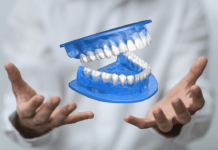The dental business is a booming structure that is constantly being introduced to new inventions and dentifrices intended to improve oral health. Whitening has become the new sought after trend that is said to be achieved naturally with the use of the popular additive charcoal. With the added benefit of being “natural,” charcoal whitening has quickly become the item that seems to check all the boxes.
How Charcoal Whitening Works
Most whitening products work by one of two ways; the first is from the inside out by chemical means, and the other uses the physical action of abrasion on the surface of the tooth to remove stains.[1] Charcoal products use the latter action to physically remove stains from the surface of enamel. The question that remains is how abrasive it is to enamel.2 Experimental studies and peer-reviewed articles focusing on the effects of charcoal on the enamel surface will be summarized and reviewed; this will be done in order to determine if any conclusive evidence that charcoal affects enamel abrasion.
Charcoal Whitening Toothpaste Studies
One study chose to test this question was with the use of an acrylic resin maple to demonstrate how abrasive charcoal is compared to toothpaste and water (control.) According to this study, it was found that charcoal is indeed more abrasive than whitening toothpaste. This test did not prove or disprove the safety of charcoal on the oral cavity, or the effects on the body, should it be consumed. They did advise against the usage of charcoal due to the actual size of the particles that have the potential to become trapped in marginal ridges, fractures, and bordering restorations.[2]
The next study performed by The Journal of Physics looked into the roughness of tooth surfaces with the use of three different methods. Using teeth that were previously extracted, researchers initially measured the buccal surface of each tooth. Then, were brushed by water, a Strong Formula toothpaste and a Charcoal toothpaste. Instead of having participants use each different dentifrice, machines were created that simulated brushing for varying amounts of time that would be the equivalent of 1 month, two months, and three months. Afterward, the initial measurements taken before the brushing simulation were compared to after the simulation. The results found that the larger particle size of charcoal was indeed more abrasive causing the surface to be significantly rougher than the control. [3]
The last scholarly article was a literature review of charcoal dentifrices as a whole. A survey of 118 articles. Among those articles, 2 found a reduction in caries, 3 had negative impacts (increased caries, enamel abrasion, or other negative impacts), and 1 article found no specific effects on oral hygiene. Internet advertisements claim charcoal toothpaste to be antibacterial, antifungal, antiviral and claim benefits to oral detoxification. These results from the peer-reviewed article demonstrate how some of the claims about the effects of charcoal can be so different and even contradictory. At this time there is no clear evidence that charcoal has any of the beneficial claims that advertisers use to draw in consumers.[4]
Charcoal Whitening Abrasiveness
As the two studies found, charcoal is possibly abrasive on the surface of enamel. The long-term problems are not yet known, but based on the limited data from these two studies, it is plausible that charcoal could lead to problems for patients for such as weakening enamel, which increases the chances that teeth are more fragile and prone to accidents or “physical forces.” [5] While these peer-reviewed articles did not draw any conclusive evidence, it did show that experiments and conclusions based on these experiments contradicted one another. Until we have larger studies that can conclusively point us in a concrete direction, at this time we just have to take caution.
With the widening of the dental market every day, we are becoming introduced to many products that may or may not work. With the growing popularity of items containing charcoal and no definite evidence to support or deny claims made by advertisers, we must do what we can to present patients with as much information as we know. As dental professionals, we are likely to be asked questions about these products, and it is up to us to help and guide our patients. It is our responsibility to encourage them to become more informed, and thus more aware of their choices and purchases.
SEE ALSO: Charcoal Whitening Toothpaste Trend: Should it Stay or Fade Away?
DON’T MISS: Oil Pulling My Leg? Separating Fact from Fiction of Oil Pulling
References
- McCarthy, Brantley, Nicholas Le_eri, Jim Singletary, and Carolyn Primus, Ph.D. “Whitening dentifrice effects on resin composites.” 62, no. 2 (2017): 110-11. Accessed November 30, 2017. doi:10.1016/j.denabs.2016.07.059.
- Ibid.
- Pertiwi, U. I., Y. K. Eriwati, and B. Irawan. “Surface changes of enamel after brushing with charcoal toothpaste.” Journal of Physics: Conference Series 884 (2017): 012002. Accessed November 30, 2017. doi:10.1088/1742-6596/884/1/012002.
- John K. Brooks, Nasir Bashirelahi, and Mark A. Reynolds, “Charcoal and charcoal-based dentifrices,” The Journal of the American Dental Association 148, no. 9 (2017): , accessed November 30, 2017, doi:10.1016/j.adaj.2017.05.001.












